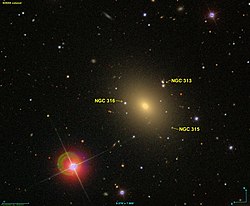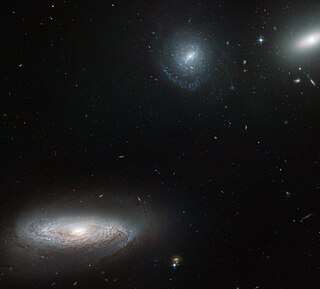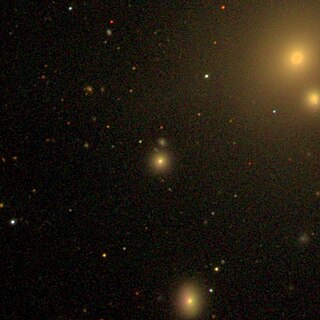| Observation data Epoch J2000 Equinox J2000 | |
|---|---|
| Constellation | Pisces |
| Right ascension | 00h 57m 52.4s [1] |
| Declination | +30° 21′ 55″ [1] |

NGC 316 is a star located in the constellation Pisces. It was discovered on November 29, 1850 by Bindon Stoney. [2]
| Observation data Epoch J2000 Equinox J2000 | |
|---|---|
| Constellation | Pisces |
| Right ascension | 00h 57m 52.4s [1] |
| Declination | +30° 21′ 55″ [1] |

NGC 316 is a star located in the constellation Pisces. It was discovered on November 29, 1850 by Bindon Stoney. [2]

NGC 125 is a lenticular galaxy located in the constellation Pisces. It is designated as subclass Sa Ring in the galaxy morphological classification scheme. It lies approximately 235 million light-years away.

NGC 128 is a lenticular galaxy in the constellation Pisces. It is approximately 190 million light-years from the Sun and has a diameter of about 165,000 light-years.

NGC 142 is a spiral galaxy in the constellation of Cetus. It was discovered by Frank Muller in 1886.

NGC 146 is a small open cluster in the constellation Cassiopeia. It was discovered by John Herschel in 1829 using his father's 18.7 inch reflecting telescope.

NGC 169 is a barred spiral galaxy located in the constellation Andromeda. It was discovered on September 18, 1857 by R. J. Mitchell.

NGC 197 is a lenticular galaxy located in the constellation Cetus. It was discovered on October 16, 1863 by Albert Marth.

NGC 237 is a spiral galaxy located in the constellation Cetus. It was discovered on September 27, 1867 by Truman Safford.

NGC 260 is a spiral galaxy located in the constellation Andromeda. It was discovered on August 27, 1865 by Heinrich d'Arrest.

NGC 274 is a lenticular galaxy in the constellation Cetus. It is a pair of galaxies, the other being NGC 275, which it is currently interacting with. It was discovered on September 10, 1785 by William Herschel. It is roughly 120 million light-years away.

NGC 280 is a spiral galaxy in the constellation Andromeda. It was discovered on December 5, 1785 by William Herschel.

NGC 285 is a lenticular galaxy in the constellation Cetus. It was discovered on October 2, 1886 by Francis Leavenworth.

NGC 298 is a spiral galaxy in the constellation Cetus. It was discovered on September 27, 1864 by Albert Marth. NGC 298 is situated close to the celestial equator and, as such, it is at least partly visible from both hemispheres in certain times of the year. Given its B magnitude of 14.7, NGC 298 is visible with the help of a telescope having an aperture of 20 inches or more.

NGC 304 is a lenticular galaxy in the constellation Andromeda. It was discovered on October 23, 1878, by Édouard Stephan.

NGC 327 is a spiral galaxy in the constellation Cetus. Also known as "The Jamie Smith Star" (ISD0534203) and was discovered on September 27, 1864 by Albert Marth. It is described by Dreyer as "faint, small, extended." It is nearby galaxies NGC 329, NGC 325 and NGC 321.

NGC 333 is a lenticular galaxy located approximately 755 million light years away in the constellation Cetus. It was discovered in 1877 by Wilhelm Tempel. It is recorded as NGC 333 in the New General Catalogue. It has a companion galaxy, named PGC 3073571, which is presumed to be a physical pair with NGC 333.

NGC 367 is a spiral galaxy in the constellation of Cetus. It was discovered in 1886 by the astronomer Frank Muller.

NGC 375 is an elliptical galaxy located in the constellation Pisces. It was discovered on September 12, 1784 by William Herschel. It was described by Dreyer as "pretty faint, small, round, brighter middle." Along with galaxies NGC 379, NGC 380, NGC 382, NGC 383, NGC 384, NGC 385, NGC 386, NGC 387 and NGC 388, NGC 375 forms a galaxy cluster called Arp 331.

NGC 380 is an elliptical galaxy located in the constellation Pisces. It was discovered on September 12, 1784 by William Herschel. It was described by Dreyer as "pretty faint, small, round, suddenly brighter middle." Along with galaxies NGC 375, NGC 379, NGC 382, NGC 383, NGC 384, NGC 385, NGC 386, NGC 387 and NGC 388, NGC 380 forms a galaxy cluster called Arp 331.

NGC 387 is an elliptical galaxy located in the constellation Pisces. It was discovered on December 10, 1873 by Lawrence Parsons. It was described by Dreyer as "very faint, small, round." Along with galaxies NGC 375, NGC 379, NGC 382, NGC 383, NGC 384, NGC 385, NGC 386 and NGC 388, NGC 387 forms a galaxy cluster called Arp 331.